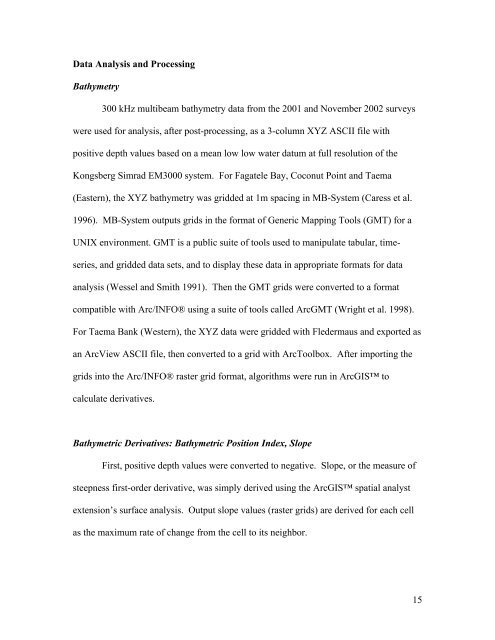A Benthic Terrain Classification Scheme for American Samoa
A Benthic Terrain Classification Scheme for American Samoa
A Benthic Terrain Classification Scheme for American Samoa
You also want an ePaper? Increase the reach of your titles
YUMPU automatically turns print PDFs into web optimized ePapers that Google loves.
Data Analysis and Processing<br />
Bathymetry<br />
300 kHz multibeam bathymetry data from the 2001 and November 2002 surveys<br />
were used <strong>for</strong> analysis, after post-processing, as a 3-column XYZ ASCII file with<br />
positive depth values based on a mean low low water datum at full resolution of the<br />
Kongsberg Simrad EM3000 system. For Fagatele Bay, Coconut Point and Taema<br />
(Eastern), the XYZ bathymetry was gridded at 1m spacing in MB-System (Caress et al.<br />
1996). MB-System outputs grids in the <strong>for</strong>mat of Generic Mapping Tools (GMT) <strong>for</strong> a<br />
UNIX environment. GMT is a public suite of tools used to manipulate tabular, timeseries,<br />
and gridded data sets, and to display these data in appropriate <strong>for</strong>mats <strong>for</strong> data<br />
analysis (Wessel and Smith 1991). Then the GMT grids were converted to a <strong>for</strong>mat<br />
compatible with Arc/INFO® using a suite of tools called ArcGMT (Wright et al. 1998).<br />
For Taema Bank (Western), the XYZ data were gridded with Fledermaus and exported as<br />
an ArcView ASCII file, then converted to a grid with ArcToolbox. After importing the<br />
grids into the Arc/INFO® raster grid <strong>for</strong>mat, algorithms were run in ArcGIS to<br />
calculate derivatives.<br />
Bathymetric Derivatives: Bathymetric Position Index, Slope<br />
First, positive depth values were converted to negative. Slope, or the measure of<br />
steepness first-order derivative, was simply derived using the ArcGIS spatial analyst<br />
extension’s surface analysis. Output slope values (raster grids) are derived <strong>for</strong> each cell<br />
as the maximum rate of change from the cell to its neighbor.<br />
15
















